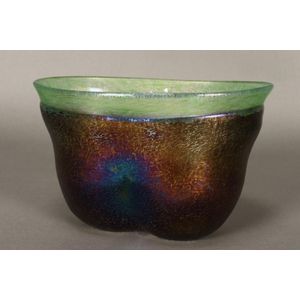Bertil Vallien Iridescent Purple Glass Vase
You must be a subscriber, and be logged in to view price and dealer details.
Subscribe Now to view actual auction price for this item
When you subscribe, you have the option of setting the currency in which to display prices to $Au, $US, $NZ or Stg.
- Overlay Glass - Overlay glass is coloured glass that has been created by sandwiching two or more layers of different coloured glass together. The layers are fused together through a process of heating and melting in a glass furnace, and the resulting glass has a unique colour and depth that is not found in single-layered glasses.
The technique of overlaying glass has been used for centuries, and was particularly popular in the Venetian glass industry during the Renaissance. Different colours of glass were layered to create intricate designs, and then the layers were carved and etched to create intricate patterns and details. - Incised - A record of a name, date or inscription, or a decoration scratched into a surface, usually of a glass or ceramic item with a blunt instrument to make a coarse indentation. Compare with engraving where the surface is cut with a sharp instrument such as a metal needle or rotating tool to achieve a fine indentation.
- Irridescent Glass - Iridescent glass has a shimmering or rainbow-like appearance due to the way it reflects light. It is created by applying a thin layer of metal oxides to the surface of the glass while it is still hot and malleable, which then creates an interference effect that produces a range of colours as the light reflects off the surface. The exact colours and patterns created by iridescent glass depend on the specific types of metal oxides used and the techniques used to apply them.
Iridescent glass was first developed in the late 19th century, and quickly became popular for use in decorative art glass and stained glass windows. Some of the most famous examples of iridescent glass were created by artists such as Louis Comfort Tiffany and his studio, who used it extensively in their distinctive lamps, vases, and other decorative objects.
This item has been included into following indexes:
Visually similar items

Chinese blue and white porcelain tea bowl, with central four characters, surrounded by kylin and scrolling foliage, diameter 7.5 cm

Charles Noke for Royal Doulton, Sung vase, chalice shape with a rich red and yellow drizzled glaze, signed to base. Height 12 cm

Two Barry Brickell yunomi, one of baluster form with dribbled lustrous caramel glaze, grind to foot where glaze has stuck, the other an early example of bowl form with maroon glaze highlights.

A John Campbell caramel glaze vase, signed to base, height 13 cm
